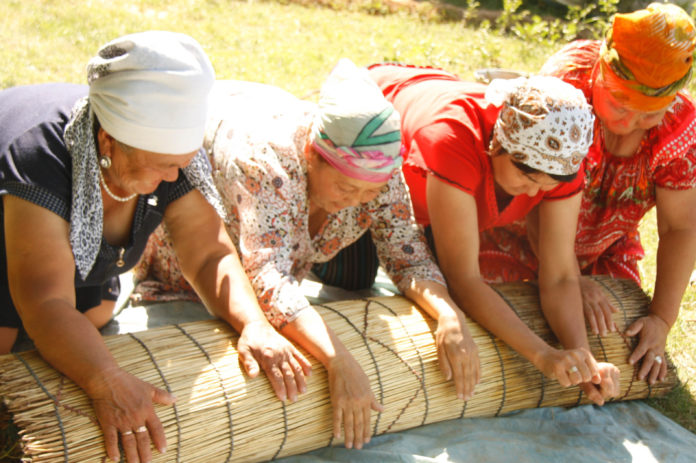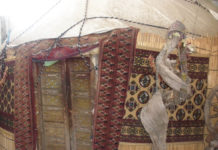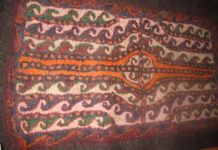Kyiz/kiiz/kigyz (felt/felt mat, in old Turkic ojlyk or covering) is a textile that is produced by pressing wool fibers together. Kiiz basu is a very ancient craft of felt-making invented by nomads and passed down for generations. Felt is a sacral element of the yurt (portable nomadic dwelling). Today felting is recognised as part of global cultural heritage. One of the earliest samples of nomadic felt found on the territory of Kazakhstan were made by Saka tribes (Scythians) and is dated first century B.C.

Kazakhs make felt using nomadic technique known as assar and Merino or Kazakh-khoy (Kazakh domestic sheep breed) wool. Creamy white colour wool was the most valuable commodity as it is associated with happiness and joy. Felt is made by a single family or the entire village. Nomadic felt has a number of benefits. It protects from cold, dust, wind, outside noise, and insects, keeps the yurt warm in the winter and cool in the summer. One of the main principles of design of felted household items are large monumental elements, rhythm of patterns, balance of foreground and background. These principles are based on nomadic philosophy and view of life: unity of man and nature, harmony of human soul and spirit of nature.
Traditional felt making is a labour-intensive process that requires skills and experience. Kazakh felt-making consist of several phases: wool shearing, hand wool processing (cleaning, washing, sabau (wool picking), boyau (wool dyeing), preparing felt rug basis (laying out wool on shyi, a natural dried grass mat) in layers built up to reach a desired thickness (usually 10-20 cm). Pattern is added using two techniques: (a) pattern is cut out of taldyrma or prefelt (pattern looks sharp when ready), (b) a desired pattern made using a wool rove (pattern looks blurred when ready). In order to achieve contrast and expressiveness sulyk is used (a different color wool thread that borders the pattern). After the pattern is added to the felt basis, the shiy (natural dried grass mat) is rolled tightly and secured with ropes into a roll. Women pour hot water on the roll and start kneading it with elbows or feet. If the roll is too bulky for women to knead, then domestic animals are used to help to roll it. The mat is unrolled and rolled back several times. More hot water is used. In order to reach a desired density a technique known as karpu is used, when the roll is thrown on the ground with force. Felt making can take several days.
There are many traditional Kazakh felting techniques, but the most iconic ones are tekemet and syrmakh.
Tekemet or oyuly tekemet (“cut out pattern”/patterned rug) is Kazakh felt wall or floor rug. It is made using a nomadic technique in which pattern (foreground) and background are cut out from two different colour prefelts. They are then felted together, melting into each other. The design looks soft due to gradual colour transition and combination of warm and cool tones. First tekemets were made by Cumans (ancestors of Kazakhs). Zoomorphic patterns prevail in the design of tekemets. Usually several rhombuses or circles are placed in the center of the tekemet, which are filled with khoshkhar muyiz (sheep horn pattern), khos myuiz (a cross-piece made of paired sheep horns), synar muyiz (one ship horn or its combination) and others. The borders of the tekemet are decorated with shet oyu or border pattern (zoomorphic patterns (sheep horns, birds), su (water waves), and other combinations of spirals (mountain, swastika, man, others). If the rug edges are decorated with hand woven or horsehair tassels, or a fringe made of goat hair, then rug is called shashakhty tekemet.
Syrmakh (syru means “stitch”) is another iconic wall and floor carpet made in traditional nomadic technique. There are around 20 syrmakh making techniques. To name but a few: akh syrmakh (white rug), oyuly syrmakh (colourful inlay pattern rug), oyistyrylghan/tyor syrmakh (solid color fabric appliqué on a white felt), syru (stitched pattern on felt), zhyiek syrmak (stitched felt rug with borders), kestelyi syrmakh (a felt rug embroidered with satin stitch). A pattern can be stitched to the background using bitpes (hand twisted cord), or zhyiek (hand weaved cord). An artisan can make syrmakh using a combination of techniques. The size of syrmakhs can vary from 1 to 6 meters and consist of 5 parts stitched together (1 bas or central part and 4 khol or borders). An artisan will spend from several weeks up to one year to make one syrmak.
Traditional felt making is practiced by the artisans of southern and western Kazakhstan. The Union of Artisans of Kazakhstan revitalises the tradition by conducting trainings and master-classes on felting and its popularisation. Tekemets and syrmakhs are widely used in official celebrations, during holidays, for yurt decorations and in rituals. As well, modern interior and fashion designers use traditional techniques and materials in their work.
Modern artisans include A. Sagynayeva, K. Zhangutty, A.Bekkulova, U. Altayeva, A. Bapanov, S. Bapanova, M. Nurkeh, U. Daulenova, N. Mustafina, K. Toleubayeva, G. Khozhamzharova, K. Aydarbekova, R. Bapanova, Zh. Beysenova and Zh. Bolegenova.





